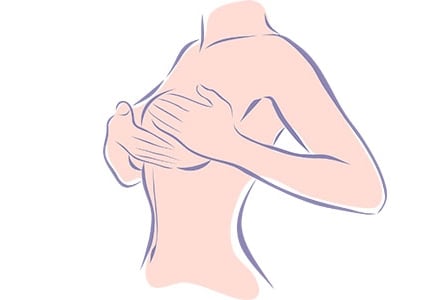
Fibrocystic breasts are caused by hormonal changes, and are extremely common, but there are things you can do.
Fibrocystic breasts, formerly known as fibrocystic breast disease, is a very common condition that mostly affects women aged 30 to 50. In fact, more than half of women will experience fibrocystic changes in their breasts at some point during their life.
What are fibrocystic breasts?
Breasts are composed of glandular tissue, fat, and connective tissue. Just like the uterus, the breasts undergo monthly changes in response to estrogen, progesterone, and other hormones. Glandular tissue is stimulated to grow, and activity of blood vessels and supporting tissue is increased.
With these changes, sometimes cysts, or fluid-filled sacs, form and may be palpable, feeling larger before each period and shrinking afterward. Unlike the uterus, accumulated breast tissue can’t be shed away and eliminated from the body. Some of the activated cells are degraded by enzymes and other cells; however, some scar tissue may be formed within the breasts, leading to fibrotic or thickened tissue.
What are the symptoms?
Whether the lumps felt are more cystic or fibrotic, they should be soft, movable, and not fixed to one spot. Pain and tenderness, both generalized or local, very commonly accompanies the lumpiness, often coinciding with the second half, or luteal phase, of the menstrual cycle.
Besides lumpiness and pain, women often report other symptoms, including the breasts feeling heavy, swollen, or full; pain or discomfort under the arms; itching or burning; as well as possible nipple discharge. Symptoms may be felt in one or both breasts. Symptoms not only vary dramatically from woman to woman, but can also vary from cycle to cycle.
What are the possible causes?
While the cause of fibrocystic breasts remains unknown, it is clear there is a hormonal contribution, since many women only experience symptoms in the week or two leading up to their period, and often feel relief once their period has started.
Also, women who experience irregular menstrual cycles may have more severe fibrocystic breast changes due to prolonged exposure to hormone fluctuations. Normally, the annoyances of fibrocystic breasts dissipate after menopause, another clue that the changes felt are due to hormone fluctuations.
Should you worry?
The symptoms of fibrocystic breasts, such as lumps and breast pain, can seem worrisome, and will often prompt women to seek medical attention. While cancer societies in both Canada and the US state that for most women fibrocystic breast changes do not increase the risk of developing breast cancer, it is important for all women to get to know their breasts and talk to their health care practitioner about any changes.
When should you seek help?
When the lumps and bumps one feels are due to fibrocystic changes, they change over time, most likely with each cycle. It is necessary to seek medical attention if there are any major changes in the breasts that persist and do not change with the menstrual cycle.
Once a woman knows the symptoms she is experiencing are due to fibrocystic breast changes—and if symptoms are mild—no medical treatment is likely needed. However, if symptoms are severe (intense pain, large cysts) some treatment may be warranted. There are many natural approaches to reducing symptoms and discomfort.
Lifestyle
Some sources suggest wearing a properly fitted bra can help with breast pain and tenderness. And when exercising, a sports bra has been found to have benefit. As well, applying heat with a heating pad or warm water bottle to tender breasts may help to relieve pain.
Diet
While studies seem to conflict about what role diet plays in the development of fibrocystic breasts, there are some diet-related factors that may either contribute to or help relieve the symptoms of fibrocystic breasts.
Fat. Despite inconclusive research, reducing dietary fat intake, specifically saturated fat (found in higher amounts in red meats and dairy), has been suggested as a possible way to reduce the incidence of symptoms of fibrocystic breasts.
Fibre. Increasing fibre in the diet, to reach 30 g per day, has been recommended to help with the symptoms of fibrocystic breasts. Eating a whole foods diet rich in vegetables, fruits, whole grains, and legumes will help reach this goal.
Water. Drinking plenty of water helps decrease the amount of fluid our body retains by flushing out what is not needed, thus helping to reduce the amount of fluid retention in the breasts.
Caffeine. Limiting the consumption of methylxanthine and caffeine-containing foods, such as coffee, tea, chocolate, and soft drinks has been suggested as a possible therapy that reduces pain and lumpiness in the breasts.
Salt. It may also be helpful to reduce the amount of salt consumed, as sodium can lead to fluid retention and breast engorgement.
Flaxseeds. The Society of Obstetricians and Gynaecologists of Canada recommends the use of flaxseeds as a first-line treatment for cyclical breast pain, at a daily dose of 25 g (2 Tbsp). Be sure to use ground flaxseeds (as opposed to oil), as it is the lignans in the seed that are thought to have therapeutic benefit.
Supplements
Vitamin E and evening primrose oil. The pain associated with fibrocystic breasts may also be lessened by vitamin E and/or evening primrose oil. Recent research has shown that supplementing with vitamin E at 1,200 IU per day, evening primrose oil at 3,000 mg per day, or a combination of vitamin E and evening primrose oil can help reduce breast pain that is experienced monthly.
Vitamin B6. Some women take vitamin B6 for fibrocystic breast pain, though evidence is not consistent on its effectiveness.
Chasteberry. Used traditionally for treating recurring breast pain, studies have shown evidence warranting further research of chaste tree berry’s effectiveness in relieving symptoms.
Always consult with your health care practitioner for the remedies that are most appropriate for you.



